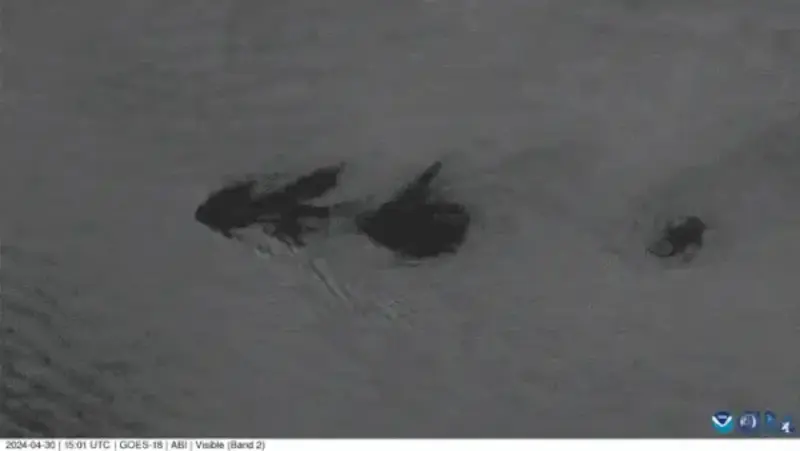
What are von Kármán vortices?
The long, cloudy chains of spiral eddies like those shown above are von Kármán vortices. They’re named after Theodore von Kármán (1881-1963), a Hungarian-American physicist who was the first to describe the physical processes that create them. The patterns can form nearly anywhere an object disturbs the flow of a fluid. Our atmosphere is composed of gases, but it flows like a fluid. And tall volcanic peaks on islands disrupt the flow of the wind to create the swirling clouds we know as von Kármán vortices. As the winds divert around these high areas, the disturbance in the flow propagates downstream in the form of vortices that alternate their direction of rotation.
Satellites have spotted von Kármán vortices around the globe. We’ve seen these vortices off of Guadalupe Island near the coast of Chile, in the Greenland Sea, in the Arctic, and even next to a tropical storm. In the satellite image above, the vortices formed in the eastern Pacific Ocean on April 30, 2024.
Images of von Kármán vortices
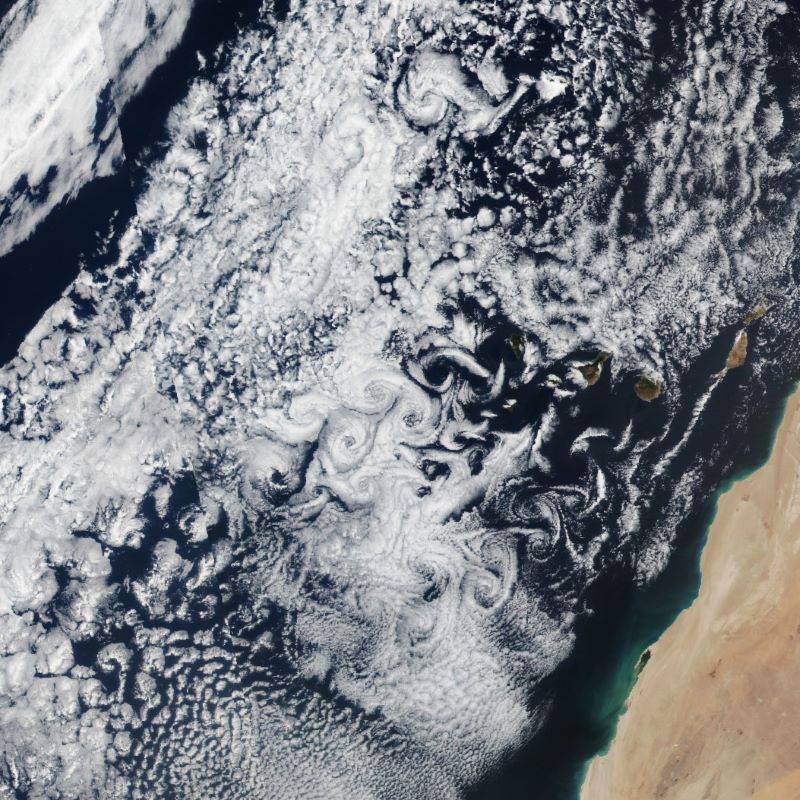
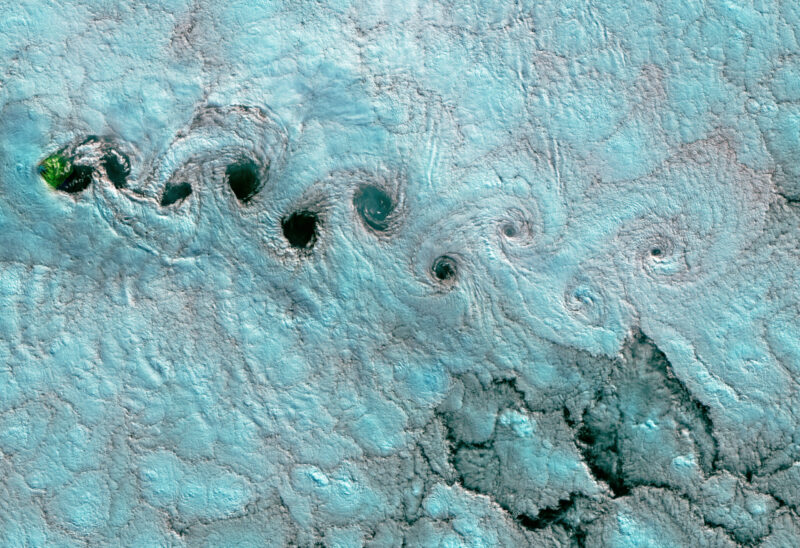
Animation of von Kármán vortices
Von Kármán vortices can form nearly anywhere that fluid flow is disturbed by an object. In the images here, that “object” is an island or group of islands. Watch the animation below (courtesy of Cesareo de la Rosa Siqueira at the University of São Paulo, Brazil) to see how a von Kármán vortex street develops behind a cylinder moving through a fluid.
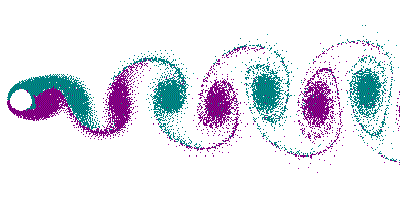
Swirling clouds over Norwegian island
In the image below, an isolated Norwegian territory in the North Atlantic Ocean, called Jan Mayen Island, is responsible for the spiraling cloud pattern. The unique flow occurs when winds rushing from the north encounter Beerenberg Volcano. This snow-covered peak on the eastern end of the island rises 1.4 miles (2.2 km) above the sea surface. As winds pass around the volcano, the disturbance in the flow propagates downstream in the form of a double row of vortices that alternate their direction of rotation.
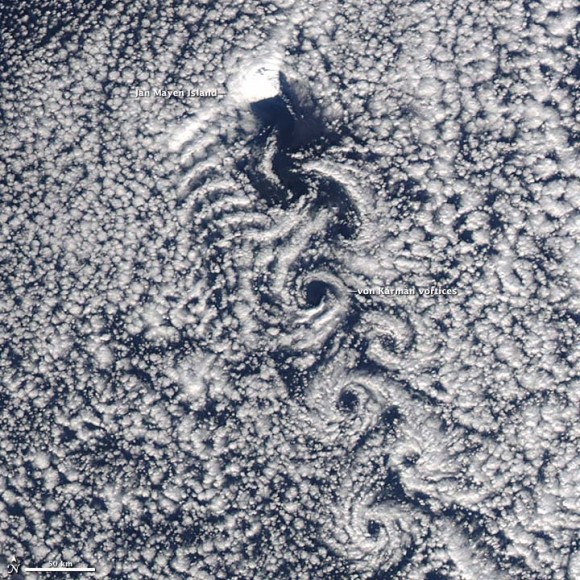
Bottom line: Learn more about beautiful von Kármán vortices, a swirling pattern of clouds visible in satellite images.
Read more from NASA’s Earth Obervatory
Read more: Cloud streets: What are they? How do they form?
The post Von Kármán vortices are beautiful, swirling clouds first appeared on EarthSky.
from EarthSky https://ift.tt/H93AV0K

What are von Kármán vortices?
The long, cloudy chains of spiral eddies like those shown above are von Kármán vortices. They’re named after Theodore von Kármán (1881-1963), a Hungarian-American physicist who was the first to describe the physical processes that create them. The patterns can form nearly anywhere an object disturbs the flow of a fluid. Our atmosphere is composed of gases, but it flows like a fluid. And tall volcanic peaks on islands disrupt the flow of the wind to create the swirling clouds we know as von Kármán vortices. As the winds divert around these high areas, the disturbance in the flow propagates downstream in the form of vortices that alternate their direction of rotation.
Satellites have spotted von Kármán vortices around the globe. We’ve seen these vortices off of Guadalupe Island near the coast of Chile, in the Greenland Sea, in the Arctic, and even next to a tropical storm. In the satellite image above, the vortices formed in the eastern Pacific Ocean on April 30, 2024.
Images of von Kármán vortices


Animation of von Kármán vortices
Von Kármán vortices can form nearly anywhere that fluid flow is disturbed by an object. In the images here, that “object” is an island or group of islands. Watch the animation below (courtesy of Cesareo de la Rosa Siqueira at the University of São Paulo, Brazil) to see how a von Kármán vortex street develops behind a cylinder moving through a fluid.

Swirling clouds over Norwegian island
In the image below, an isolated Norwegian territory in the North Atlantic Ocean, called Jan Mayen Island, is responsible for the spiraling cloud pattern. The unique flow occurs when winds rushing from the north encounter Beerenberg Volcano. This snow-covered peak on the eastern end of the island rises 1.4 miles (2.2 km) above the sea surface. As winds pass around the volcano, the disturbance in the flow propagates downstream in the form of a double row of vortices that alternate their direction of rotation.

Bottom line: Learn more about beautiful von Kármán vortices, a swirling pattern of clouds visible in satellite images.
Read more from NASA’s Earth Obervatory
Read more: Cloud streets: What are they? How do they form?
The post Von Kármán vortices are beautiful, swirling clouds first appeared on EarthSky.
from EarthSky https://ift.tt/H93AV0K

Aucun commentaire:
Enregistrer un commentaire